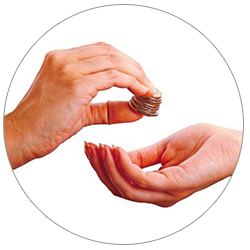
Surprisingly, humans are much less “logical” than we’d like to think. According to Antonio Damasio, a renowned neuroscientist, emotions might be hidden, but they still drive almost everything we do whereas rational thinking comes second. In particular, he studied people with damage in the part of the brain responsible for emotions production, who being emotionless seemed to be absolutely normal. Nonetheless, the patients had one more very interesting feature - they couldn’t make even the simplest decision. Basing on the conducted research, it can be said that every decision people make, especially such important one as purchase on an e-commerce platform, has its prevailing emotional side. For e-commerce store owners, understanding this can also inform critical decisions like choosing the right platform, or even when to consider a website migration.
Now, let the greed possess your thoughts. Can we take financial advantage of this fact? Of course we do, and what is more important, we’ll learn how to intentionally exploit consumers’ emotions in order to increase sales. Though every time we are justifying our purchases as completely rational decisions, sly marketers know they are not, and have been effectively appealing to our feelings for decades. This strategic approach is also key when considering a successful e-commerce re-platforming. Why can’t we, e-merchants, give it a try?
So, what are the emotions of a prime importance for a salesperson to trigger? Geoffrey James claims that every purchase decision comes down to a “cocktail” of 6 feelings: greed, fear, altruism, envy, pride and shame. Choosing which to focus on depends on what aims your customers persecute and the solution you offer. Once you’ve determined the beliefs and feelings that will resonate with your target audience the most, create an emotional message they just can’t resist. Here is a few thoughts on 4 of those emotions (envy and shame are omitted due to similarity with pride and fear) with short examples for better understanding. Much like optimizing for emotional triggers, ensuring a smooth basic data migration lays the groundwork for e-commerce success.
Greed: "If I make a decision now, I will be rewarded."

No, being somewhat greedy is not a crime; after all we’re all motivated by desire get more, earn extra and spend less.
- Lay stress on personal benefits. Customers are done with mere features enumeration - tell them about the benefits! Example: Instead of concentrating on details of sportswear “brand new manufacturing technology”, point out personal records sportsmen will be able to set. The increase in speed, improvement of comfort, gain in strength - that’s what matters for buyers. In numbers, preferably. Just as results are crucial here, it's vital to check demo migration results meticulously for a new store.
- Tell stories of your customers’ success. If you have a client who hit the jackpot thanks to your product - let the world know. Example: “Before buying our book, Harry Louis was a deedless, young student on a shoestring budget. But “The Secrets of Financial Prosperity” has literally changed his life! Just in a year afterwards, he became an entrepreneur and earned his first million! Here’s how did it happen...”
Fear. "If I don't make a decision now, I'm toast."

Fear is one of the greatest motivators to take action. Wouldn't it be great if we could use it to increase sales? And we can, in fact.
- Dwell on the cost of hesitation. Take a peek at the future - often frightening itself for most of us - where the customer had a chance to make a purchase but didn’t. And hint it was a bad choice. This feeling is akin to the risks of delaying essential updates or a necessary store migration. Example: suggest some unfortunate scenarios and dwell on them: “What happens if you don’t make the choice now?” or “How long can you suffer without a comfortable mattress?”. Also, you can state some of the fearsome assumptions as a fact: “The terrific effect of cheap cosmetics on your skin”.
- Point out what customers are going to lose. Due to human nature, we’re more afraid to lose something we already possess than not to gain more. Use this knowledge in pushing customers to take action. Example: “You lose up to $20 a day on office expenses using ink consuming printers!”
Altruism. "If I make a decision now, I will help others."

Appealing to customers’ altruism can cause an unexpectedly positive results on the sales. The thing is, when customers see they can contribute into a good deed by purchasing, they do because they feel it’s morally right.
- Mention a public-spirited aim. Improve your karma by starting a little charity campaign - customers would love to purchase if they know not all of the profits are going to settle in merchant’s pockets. Example: Give people the feel they can help others: “Buy a pair of shoes and we’ll give away another one to a person in need” or “10% of the profits goes on the needs of Greenpeace organization”
- Specify the benefits for those who close to them. People value their relatives and friends the most, so little mentioning of benefits they’ll share can make a great influence on the purchase decision. Example: “Make an unforgettable present to your loved one - buy her a necklace only for $499.” or “Take care of your friends, buy them *common beer trademark*”.
Pride. "If I make a decision now, I will look smart."

Can your offer help customers to boost their pride, win respect and make competitors envy? Undoubtedly, every product can if it’s good. So make something up.
- Emphasize the positive effect on their social self-image. Trigger customers’ imagination by outlining what social attitude will be. Example: “No one will resist the charms of your new perfume” or “Our toothpaste will whiten up your teeth and make others green with envy!”
- Praise them a little. Make your customers feel proud of themselves before they even actually did anything. Example: Note on your customers’ good taste, advanced professional skills and deep personality - that’s what all of us want to think. Such phrases would do: “This suit costs $899. You’re worthy of two of them” or “We sell building equipment for professionals. Yes, for you”.
These are a few examples of how emotions can help you to get in control of customers’ decisions and start selling more. Do you know any other tips on how to take advantage of emotional human nature? Share the in the comment section below!
Monthly Update – December 2025
As we close out 2025, a key trend in e-commerce leveraging emotions is the rise of hyper-personalized shopping experiences driven by advanced AI. Customers are no longer just looking for products; they're seeking connections and solutions tailored to their individual emotional needs. Retailers are deploying AI to analyze vast datasets, including past purchases, browsing behavior, and even sentiment from customer service interactions, to predict what will resonate emotionally. This allows for dynamic product recommendations, personalized offers that address latent fears (e.g., "limited stock for your size") or appeal to pride ("exclusive access for valued customers"). Brands are also increasingly transparent about their ethical sourcing and sustainability efforts, tapping into consumers' altruistic desires to support responsible businesses. The holiday season of 2025 has particularly highlighted the effectiveness of these strategies, with emotionally intelligent campaigns driving significant engagement and conversion. By focusing on creating an empathetic and responsive shopping journey, businesses can cultivate deeper customer loyalty and significantly enhance sales. Looking ahead, expect even more sophisticated integration of emotional intelligence into every touchpoint of the online retail experience.
For more details, explore our FAQ section or schedule a call with a migration expert.



